If your business needs more qualified leads that convert, you might want to read this.
With over a decade of lead generation and close to 7000 qualified leads generated last year, we have pretty much mastered LinkedIn prospecting.
The following LinkedIn hacks for lead generation work for us.
And we know that the same tips and tricks will help your business generate high-quality leads. (Even as soon as the first 48 hours after launching your outreach campaign on LinkedIn.)
(And if you have any questions on how to generate more leads, we offer free 15-minute consultations, as well as a done-for-you lead generation service that guarantees 20+ leads per month.)
1. Invest in the right LinkedIn lead generation tools – Not just Sales Navigator
The problem with most sales professionals is that when they use LinkedIn to find b2b leads, they only use LinkedIn Sales Navigator to build a list of prospects.
But what we have found is that Sales Navigator isn’t always accurate.
We actually go off Sales Navigator and use third-party data providers because it gives us the freshest, most accurate data.
This article shares some of the biggest issues with Sales Navigator and how to get around them.
But for example, you might want to use Sales Nav keyword tool, thinking that the results will be accurate, but unfortunately, this isn’t always the case.
Have a look at the example below:

If you type in the word “cold emailing” in the keyword section, LinkedIn might show you profiles of LinkedIn users that have nothing to do with cold email.
Like the example below.
We typed in the keyword “cold emailing” and it brought up a whole list of accounts.
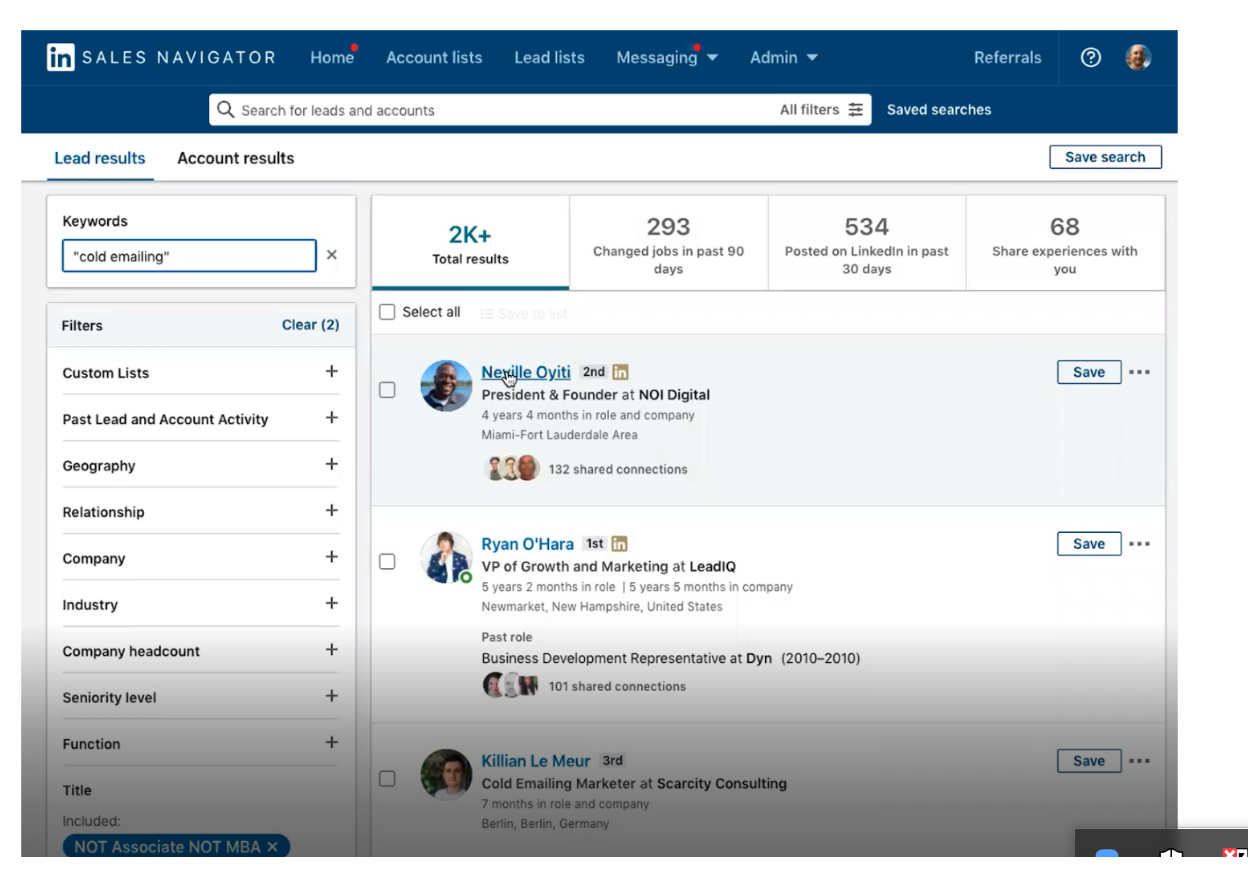
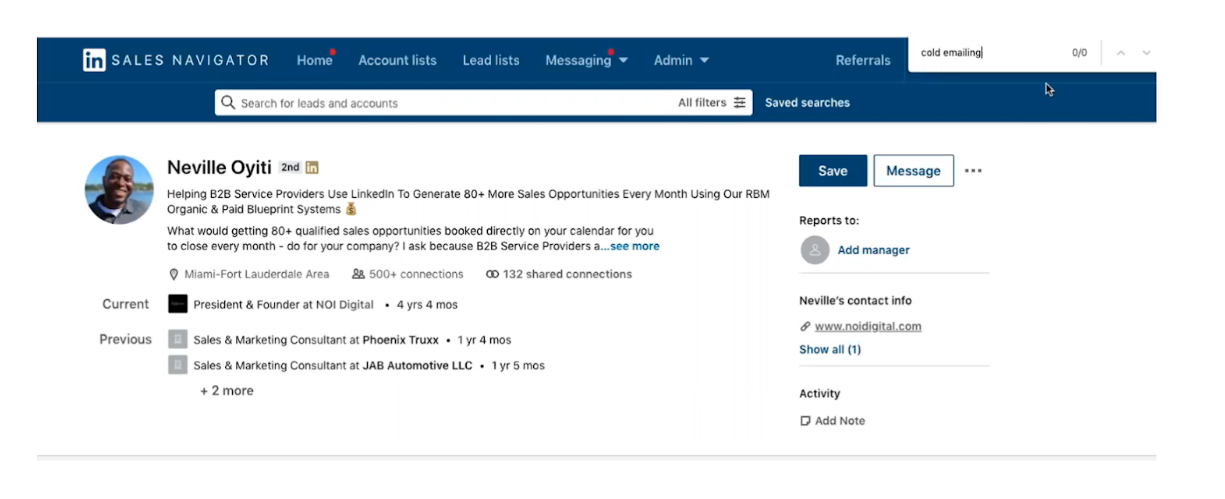
So if you are using the keyword tool to find prospects, you might actually be reaching out to the wrong people.
But there is a hack for this issue:

By doing an X-ray search Google brings up all people who actually have this keyword in their profile with 100% accuracy.
Google actually crawls and indexes all LinkedIn profiles and Google’s tech is far more advanced than LinkedIn.
This is an incredible hack for the keyword filter in Sales Navigator, so instead, use an X-ray search for more accurate results.
But read this article because it explains all our hacks for LinkedIn Sales Navigator.
Back to investing in other lead gen tools:
As we mentioned above we actually go off Sales Navigator and use the following tools to get the most accurate data on prospects.
Some of these tools aren’t too badly priced, so it’s worth your while to make use of them if it means being able to build accurate prospect lists.
Some of the prospecting tools we suggest are:
Linkedin Sales Navigator
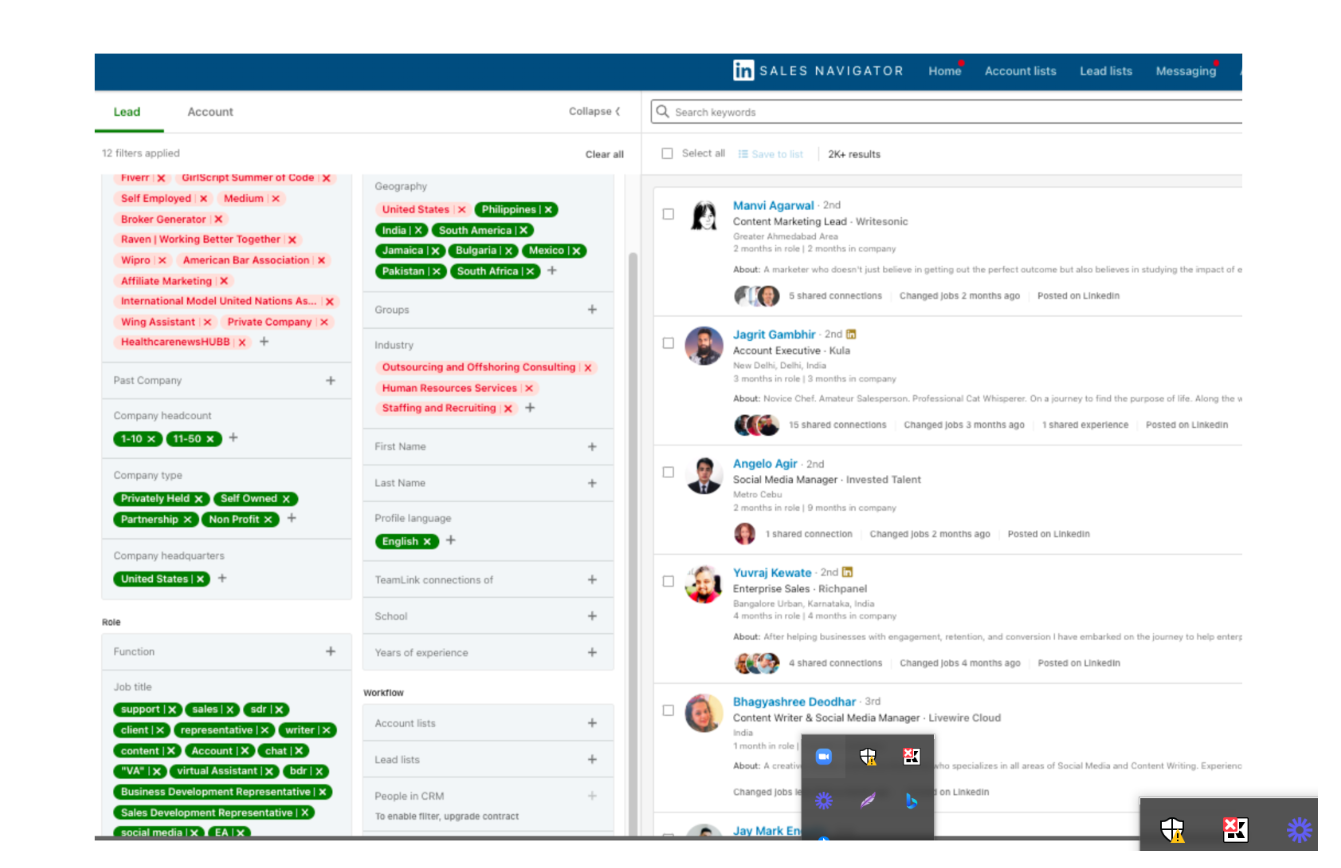
Linkedin Sales Navigator is an excellent tool for targeting specific people.
But you need to know how to use this tool the right way.
For example, the industry filter on LinkedIn Sales Nav is notoriously inaccurate because it’s mainly user-selected.
If you’re selling a health and fitness app, you could list your company as health, health, and fitness or even tech.
See the problem?
You could be missing out on half of your new leads because they have labeled themselves as something different, from what you’re thinking.
Read this article on how to use Sales Navigator the right way.
How much does it cost?
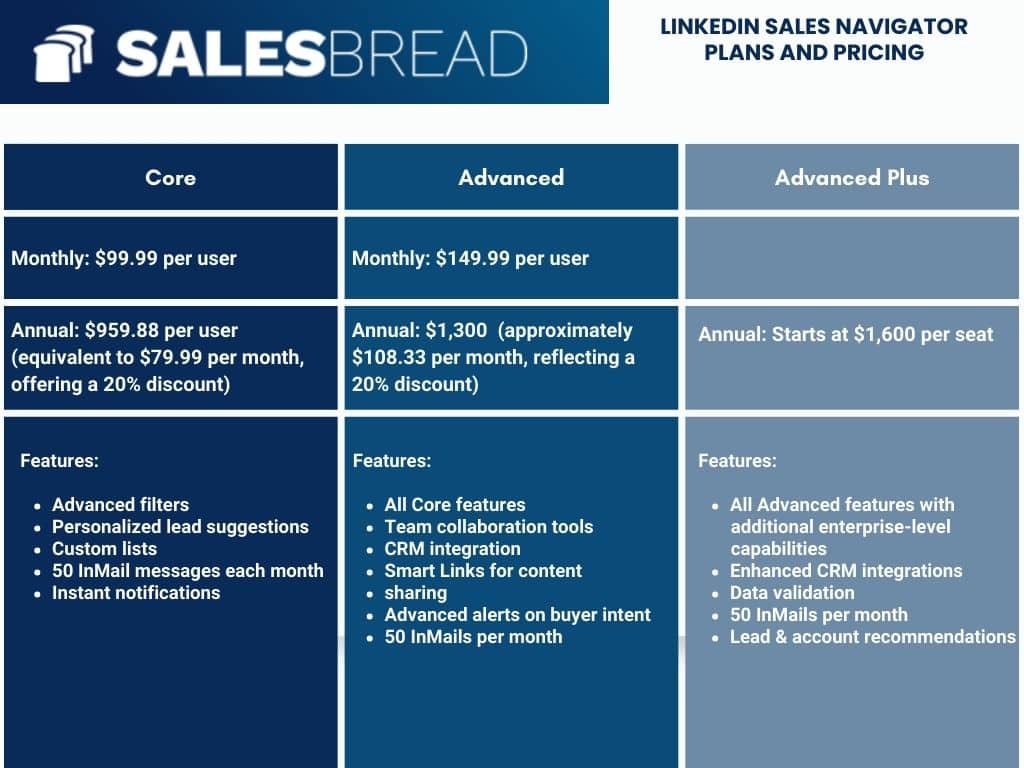
Crunchbase

Crunchbase helps us filter our list of look-alike customers even further.
Especially if you are looking to target b2b companies.
See the above screenshot on various filters that you can use to build an ultra-targeted list of prospects.
How much does it cost?

Expandi.io

Expandi is an automation tool that we use once we have all the accounts that we have found for our list. We then use Expandi to pull and plugin the data into the Sales Navigator search.
You can then grab each search URL, and Expandi will scrape those prospects for you and add them to a connector campaign automatically.
How much does it cost?

Zoominfo

Zoominfo is a powerful tool that offers the best buyer intent data. Just note that it’s an extremely expensive tool, and would be best suited for larger companies.
But most of its features are comparable to Crunchbase and Apollo.io.
How much does it cost?
The most basic package starts at around $10 000 a year.

Apollo.io

We use Apollo for data mining. It allows us to find the email addresses and phone numbers of contacts on Linkedin. You can find your ideal prospects with laser-focused details.
Apollo.io scrapes all the info off Linkedin, so when it comes to finding info about companies, for example, it allows you to essentially do a Linkedin search, but far more effectively.
How much does it cost?

Apollo isn’t as expensive as Zoominfo, but still a great tool for finding your ideal target audience.
Side Note:
At Salesbread we pay for most of these tools every month.
This means that if you do decide to partner up with us, you won’t have to pay for these tools which can cost a pretty penny if you choose to make use of most of them.
2. Build a prospect list based on data
Have a look at the companies who have purchased your product or service within the last 6 months.
( Read this article on list building for an in-depth look at how we do it.)
What do all your buyers have in common?
Building a list of potential customers is a lot more than just saying “I need leads in the healthcare space” (for example).
You actually have to look at current buying data and find patterns (or commonalities) between your buyers.
For example, if you need leads in the healthcare space, ask yourself:
Are all your current buyers:
-
Located in the same area?
-
What are the demographics of those buying from you?
-
Who is buying? Hospitals? Clinics?
-
What’s the company size? Do they have more than 500 employees or less?
-
Is it non-profit?
-
Which job titles are buying from you? Is it the marketing department? CFOs or VPs?
Once you establish patterns it’s easier to build look-a-like lists of prospects to reach out to.
Below is an example video of how we would do it:

By using a visual depiction of buyer data, you can quickly see who to target.
For example in the above image, you can see some basic patterns emerging. We refine the above data until it helps us build a look-alike list of prospects.
Eventually, our chart looks like this:

This visual depiction will help you build the right segments to go after.
Why is an ultra-refined list of prospects important?
Because most lead generation companies just do basic targeting.
And this is why their leads aren’t qualified or why conversion rates are low.
We make sure to go after prospects who:
A.) Need what you’re selling
B.) Have the budget
C.) And who has the purchasing power to buy? There is no point in reaching out to a sales rep when it’s only the CEO who is the decision maker. This is why going after the right job titles is also important.
Hack 3: Write personalized LinkedIn outreach messages
Studies show that 90% of U.S. consumers find marketing personalization very or somewhat appealing. – (Statista) And 70% of Millennials are frustrated when they are sent irrelevant emails.
This means that if you want a prospect to reply to your connection request or follow-up message, YOU HAVE TO add personalization to your marketing strategy.
When messages are personalized they stand out from every other generic b2b marketer out there.
Remember that most messages are also automated. Prospects know this.
And let’s face it.
How often do any of us reply to an automated sales message?
Chances are probably never (unless we really want what the company is offering.) but most of us have inbuilt spam detectors.
When a message comes across, and we know it’s been sent to every other person on Li, we ignore it.
But what happens when you receive something in your inbox that’s directed at you?
(The message was tailor-made, and even mentions something personal about you..)
You stop and read it.
Why?
Because it cuts through the noise. It’s something different that stands out.
Here are 2 examples:
Example 1: No personalization and a straight-out sales pitch
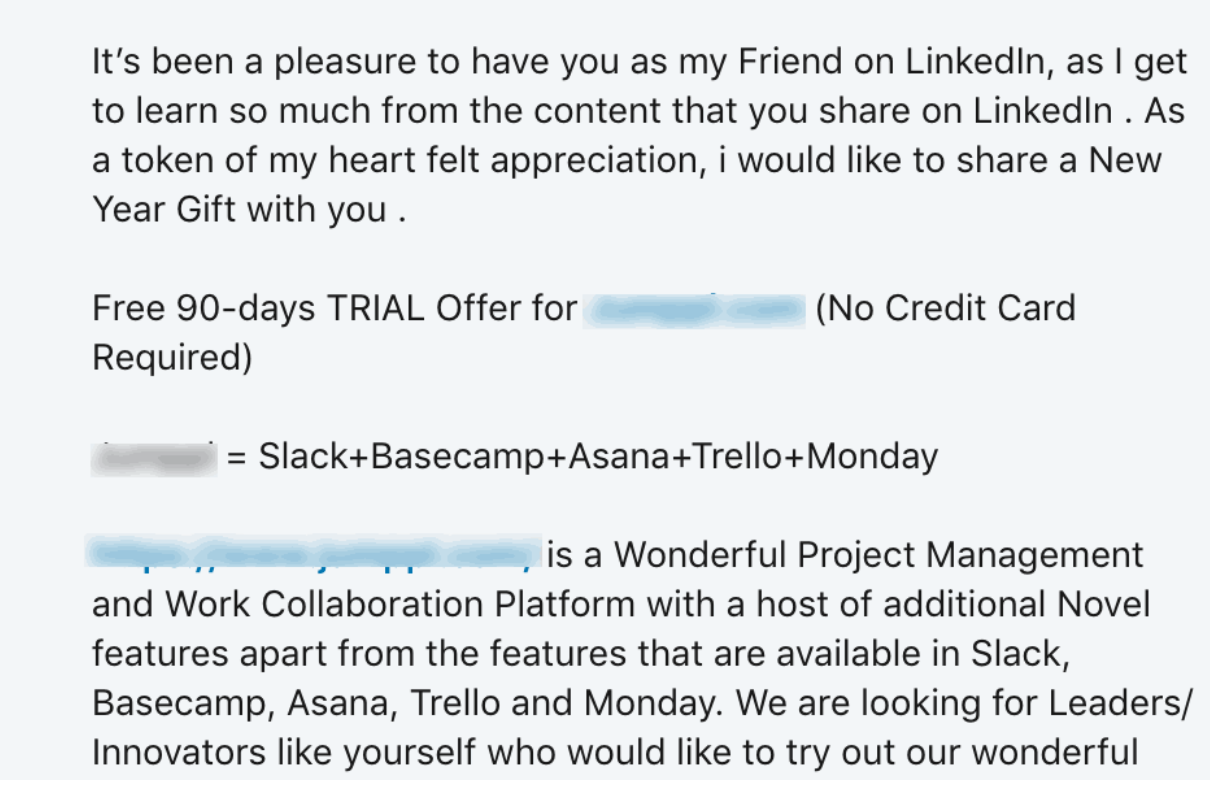
This salesperson hops straight into a sales pitch with absolutely no personalization.
Would you reply to this? Probably not.
Below is an example of how we would send a personalized message to a prospect.
Example 2: Personalization

Notice…
No sales pitch.
Plus we asked the prospect a question. Then at the end of the message, we added a Ps. for background information on why we were asking them the question.
How to personalize an outreach message
Personalization isn’t difficult. It just takes time.
At Salesbread we have a full-time employee who only focuses on writing personalized messages.
How does she do this?
Look at your prospect’s LinkedIn profile
Well, she actually reads through each prospect’s LinkedIn profile and looks for nuggets of information that she can use in her messages.
We either ask the prospects a question, share a commonality, or compliment them on something that’s mentioned in their profile.
In the example above we asked a question, but you can also share commonalities, for example, mention that you are both in the same LinkedIn groups or that you both know the same people.
When it comes to compliments you could mention how you enjoyed an article that the prospect wrote, or how you enjoyed their LinkedIn post on XYZ.
Remember personalization is about starting conversations. You just want to get your foot in the door so that you can ask for a sales meeting.
This article shares how we write thousands of personalized messages using the CCQ method.
Side note:
If you’re using Linkedin, don’t just rely on InMail. Filter your prospect list by your second-degree network and by recently posted, then reach out to these prospects first.
Why?
InMail isn’t as effective as you think it might be. We find that prospects aren’t as keen to reply to InMails, probably because it’s a paid-for service.
But when you reach out to prospects who are in your second-degree network, your reply rates will be higher because you have shared connections.
If they have already accepted people like you in the past, the chances of them accepting your connection request will be greater.
It also tells you that they have a specific network size and that there is someone behind the Linkedin profile who is likely to accept people who are relevant to them.
Why filter by recently posted?
Because this ensures that you are reaching out to prospects who are active on the social media platform. If a prospect isn’t active on Linkedin, we will send them an email or an SMS.
4. Follow up consistently

The above message is an automated message that I received more than once.
Before I knew much about automation (before I worked at Salesbread) I actually replied to this message and only received an automated reply, pretty much saying the same thing.
Another example is of an automated email that was sent, and once we replied with a question, another automated response was sent out.
This, in turn, made us lose interest in the company’s service because we were hoping to have a person respond to our question.
And this is how most people feel when they interact with automation tools.
Yes, automation has its place but don’t automate everything in your Linkedin messages.
It’s important to reply in person to a prospect because it creates a human touch and proper engagement.
If a prospect has a question, you can answer them in real time, this is so much better than having a generic robot reply.
5. Always ask for a booked sales meeting
We have found that some sales reps are nervous to ask for a booked meeting.
But we noticed that when you have a clear CTA, prospects are more willing to respond and it weeds out prospects who are really interested from those who aren’t.
Here are some CTAs that you can use in your Linkedin lead generation strategies that get replies.
1. Are you available for a quick call in the next few days to see if [MY PRODUCT] aligns with your goals?
2. When are you free to connect this week? You can use this link to book directly on my calendar.
3. Can we target {{=bday+2}} afternoon to discuss [BENEFIT/PROBLEM]?
4. What’s the best way to schedule 5 minutes to talk?
5. Would you have some time next {{=day}} to discuss?
6. If you find the spec interesting, should we set up a confidential chat?
7. Can we grab time Thursday afternoon to see if [MY COMPANY] aligns with your goals for this year?
8. Are you available for a quick meeting to discuss your use case and see if we can assist in any way?
9. Do you think it could help {{company. name}}? If so, happy to tell you how (here’s my calendar) or show you a demo.
10. Would you be open to a high-level call to learn more?
11. Do you have 10 minutes in the next few days to see how video can generate sales and reduce acquisition costs for {{company.name}}?
12. Would you have time {{=bday+2}} morning for a conversation?
13. Want me to coordinate with your assistant?
A clear call to action lets prospects know exactly what you want them to do, and it shows them where you would like the messaging to go.
It’s important to only sell in a sales call and not in your outreach messages unless you have a “slam-dunk” product that is a total no-brainer (then you could offer it in your sales message.)
Frequently asked questions about LinkedIn hacks
1. What are the best ways to find leads on LinkedIn?
Utilize Advanced Search Techniques: While LinkedIn Sales Navigator is a valuable tool, its filters, such as the industry filter, can sometimes be inaccurate.
To improve accuracy, consider using third-party data providers or advanced search techniques like Boolean searches to pinpoint your ideal prospects. Also, make sure that you build a list of prospects based on current buyers’ data.
Optimize Your Profile: Make sure that your LinkedIn profile is up-to-date and professional.
A professional profile not only attracts potential leads but also establishes credibility. This means that prospects will be more willing to reply to your messages.
2. How can I use LinkedIn groups to generate more sales leads?
Join and Engage in Relevant Groups: You could also participate in LinkedIn groups that align with your target audience’s interests.
By sharing valuable insights and sharing in discussions, prospects might view you as a thought leader, which can attract potential leads.
3. What is the best strategy for connecting with prospects on LinkedIn?
Personalize Your Outreach: Avoid generic messages. Instead, research your prospects through personalized LinkedIn connection requests and tailor your messages to something specific about the prospect.
Your messages should also reflect genuine interest and not just be about the sale. This approach increases the likelihood of positive responses.
Provide Clear Calls to Action: Ensure your messages have a clear CTA that’s easy to follow through on, guiding prospects on the next steps helps reduce ambiguity.
4. What are some common mistakes to avoid when using LinkedIn for lead generation?
Over-Reliance on Automation: While automation tools can be helpful and help save time, don’t automate everything. Why?
Because this can lead to impersonal interactions, which means you’re going to get ignored.
It’s important to balance automation with genuine, personalized interest to build proper business relationships.
Need more LinkedIn lead generation tips?
Reach out to us for a free 15-minute strategy session. We would be happy to help you generate more qualified leads for your company.
(Not yet ready to partner up with us? Read this article to see exactly how we work and how much we cost.)
